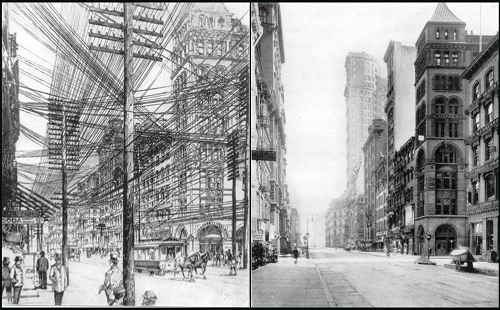The Libertarian Power Grid of the 1890s New York City
The image on the left is the original 1890s NYC grid of power and telegraph cables, built by a hodgepodge of competing wire-running firms. A blizzard blew all of it down, causing chaos. After this, the city decreed that all cables are to be buried and passed regulations governing how it is to be done. The picture on the right is of the city after this had taken place.
The construction of multiple electric grids in a city is an almost tragicomical duplication of effort. And yet, we see a very similar situation in today's computer software, where a single machine may have a dozen simultaneously operating memory allocators / garbage collectors, graphical subsystems, web content renderers, and many other essential services which in a sanely designed system would exist in a "one true" incarnation, provided by the OS itself.




You smoke too much weed.
Nice analogy. Are you advocating the government mandate one single high level framework? I'm pretty sure you would be much less happy with that. Of course, in Microsoft's world, they already have this: .NET.
To an extent, the government is currently mandating multiplicity: copyright means that even if someone's already written something, you can't have it unless you write it yourself. Loosening copyright, or mandating source code release, or something, would do the job here.
The duplication of effort is not the issue. People reinvented the wheel wherever and whenever that was the most expedient option. And unlike in a city, duplicate systems are not competing for extremely limited space. 50mb of code duplicated 12x is not going to bring a modern system to its knees. You could make an argument for the negative effect of duplication on performance, but that's small fry.
The primary cost of duplicated systems depends entirely on the system in question. When there are duplicate graphical subsystems, the UI apperance is inconsistent from application to application, which degrades usability. With duplicate web content renderers, you have to personalize your settings N times instead of just once. With duplicate cron systems you have to look in N places to get an overall picture of every job that runs.
It is unfortunate that so many "essential services" have not yet been pushed down into the OS (or even lower), but it is not for the reasons that you hint at.
Nobody writes 50MB of code, at least not if it's general-purpose enough to be used twelve times on the same system...
And the issue is not performance or disk space, it's a matter of human effort, twelve organizations should not write twelve separate implementations of the same thing, that time could be spent solving real problems or maybe making one or two implementations stable, secure and sexy.
I think all of the wires clouding the skies are yet another example of the tragedy of the commons. If someone actually owned and responsibly managed, there would have a charge to run all of those wires. The city eventually woke up due to political pressure, but an actual property owner would have behaved differently from the beginning.
And that property owner would most likely have been some sort of cooperative entity formed by the property owners lining each particular street. Such entities would have bargaining power together and would likely have been able to strike a very favorable deal with a single vendor.
What eventually happened in reality would have been accomplished more quickly with more private property.
tragedy of the commons is a bunch of fucking bullshit. it's pretty much an excuse for handing out stuff that should have free access and use by the community that uses it to private individuals. We need less private property (not in the sense of your house or your car, more in the sense of a factory)
Al Brown; yah, and then economies of scale would be thrown right out the window, because how would you build a citywide grid when you had to negotiate individually with a hundred different, possibly overlapping, entities claiming to own the poles and whatever carried mounting mechanisms and regulations they had.
Of course, libertarian fucks have no clue what the State actually does, so there ya go...
[...] Late 1880s: above, a profusion of telegraph lines in NYC, before and after the great blizzard cleared them away (Swiped here.) [...]
In the drawing of the 1890 situation, remember the situaton: for the first time in human history, there was a nexus of high-speed communication. To modern eyes, it looks cluttered--to those of the time, it was the hallmark of huge technological advance. In 1890, 99% of humanity lived in dirt (i.e., in nature), on unsanitary farms or at rice paddies (swamps) or maybe, if they were lucky, in little dirt-road villages. Wall Street (or London's City) was like Silicon Valley and Cape Canaveral multiplied together. The wires were awesome, not eyesores.
It is anachronistic to judge the sights of 1890 with 2012 eyes.
(I also agree with Al Brown that property rights not government direction is the way to progress.)
Dear Harry Binswanger,
Yes, I'll take a city with twenty-five separate overhead electric grids over the dirt village. But it is still a disaster zone. Multiple electrical and communication grids are an engineering disaster, rather than merely ugly. And, interestingly, sabotage of competitors' lines was easy and just about undetectable.
Proper management of public rights of way (not only roads, but sewer, water, telephone, electric lines) is one of the main attractions of statism. Anarcho-capitalist types (as your web site suggests you might be) tend to work around this problem by suggesting that large property owners can fill the role of the State with respect to public rights of way. As I gather, this kind of thing merely re-creates the State under another name. If a man privately owns a city, then he is simply a feudal-type lord, though perhaps lacking the lordly rights of infangthief and fossa et furca.
Yours,
-Stanislav
[...] lines BEFORE GOV and then WITH GOV! http://www.loper-os.org/?p=38 The image on the left is the original 1890s NYC grid of power and telegraph cables, built by a [...]
an os like.. ? is there any 'historical' example?
The Genera and many LISP systems before it.
The current state of affairs where, for example, each implementation of a high level language has to provide it's own garbage collector (because no standard one is provided, partially because writing a general garbage collector for the horrifying "C machine" is pretty much freaking impossible) is preposterous.
And the idiots clap along... after all, managing memory manually like a chump gives us teh speed and teh big coding schlong!
I'm afraid I was born too late for lisp times.
I'm not sure but http://stackoverflow.com/questions/1848029/why-not-port-linux-kernel-to-common-lisp it seems manual memory was the problem.
Anyway ram is quite cheap.
I think this is nice analogy. I was interesting to read this.
Could you tell me the source of the right picture?
I could not found this by searching in the image on Google.
Is this you quoted from the book or something?
how is having multiple browsers on a computer bad?
Can I use the picture for my blog post?
Dear Brent,
If you like. (And it isn't as if I personally snapped it!)
Yours,
-Stanislav